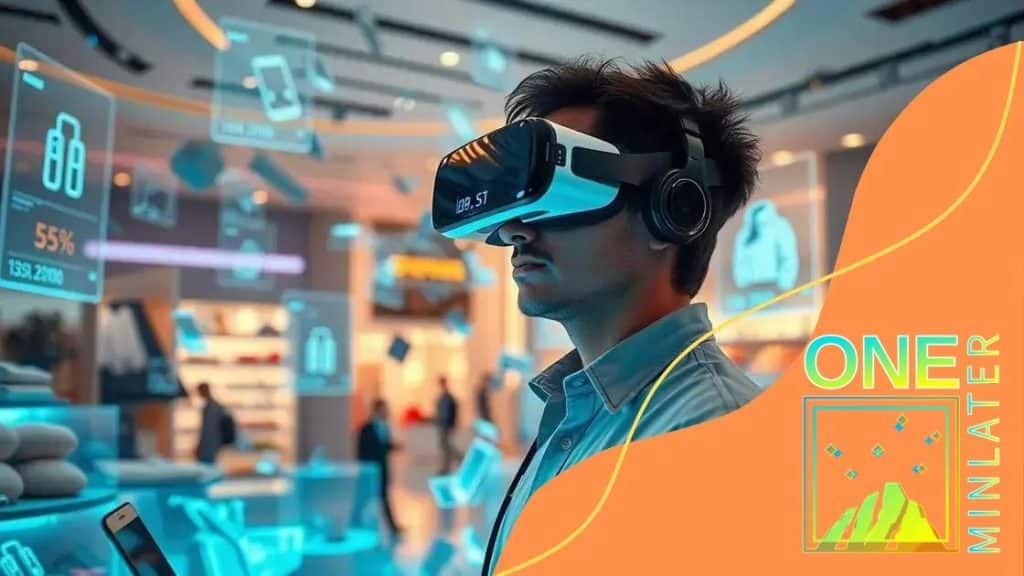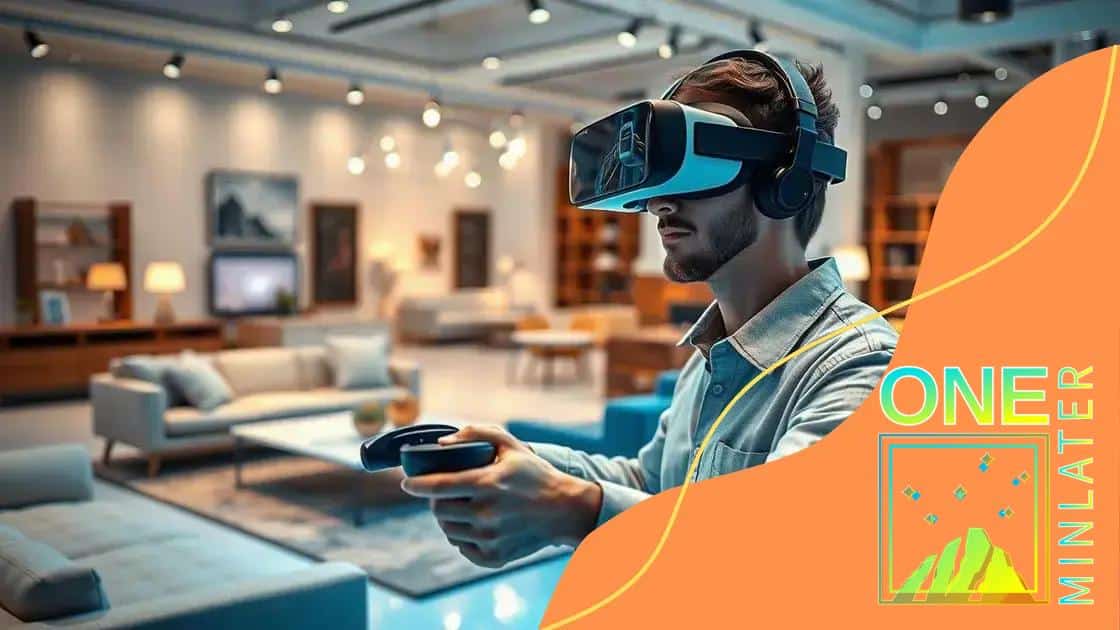The future of e-commerce with virtual reality integration

The future of e-commerce with virtual reality integration enhances customer engagement through immersive shopping experiences, personalized content, and effective product visualization, while also addressing challenges like costs and technical issues.
The future of e-commerce with virtual reality integration promises to revolutionize how we shop online. Imagine being able to try on clothes or see furniture in your living room before making a purchase. Exciting, right? Let’s explore how this tech is changing the game.
Understanding virtual reality in e-commerce
Understanding virtual reality in e-commerce is crucial for grasping how technology enhances online shopping. With virtual reality (VR), consumers can explore products in a whole new way, blurring the lines between the digital and physical shopping experiences.
What is Virtual Reality?
Virtual reality is a computer-generated environment that simulates physical presence in the real world. Shoppers can use VR headsets to enter a 3D space where they can interact with products virtually. This technology not only creates immersive experiences but also allows buyers to make more informed decisions.
Benefits of VR in E-commerce
VR brings several benefits to online retail, making it an attractive option for both consumers and businesses. Here are some key advantages:
- Enhanced Customer Experience: Consumers can try products before buying, improving satisfaction.
- Increased Engagement: Interactive experiences keep users intrigued longer, boosting sales.
- Reduced Returns: By visualizing products clearly, shoppers are less likely to make errors in purchasing.
Moreover, VR can simulate the shopping environment, allowing customers to navigate through stores as if they were physically present. For example, customers can walk through virtual aisles and examine items closely.
How It Works in E-commerce
In e-commerce, integrating VR involves several steps. Retailers create 3D models of their products and environments, then use VR software to allow navigation. With a headset, customers are transported right into a virtual store, where they can interact with merchandise.
This technology is particularly valuable for products that require a closer look, such as furniture or fashion items. By placing these items in their own space, customers can envision them in real life, which aids purchase decisions.
As VR continues to develop, it promises even more advanced features, like personalized shopping experiences tailored to individual preferences. The future looks bright as more e-commerce platforms adopt this transformative technology.
How VR enhances customer engagement
How VR enhances customer engagement is an exciting topic as it dives into innovative ways businesses connect with their customers. By using virtual reality (VR), companies can create immersive experiences that grab attention and keep users coming back.
The Interactive Experience
One of the main ways VR enhances engagement is through interactivity. Instead of just window shopping, users can explore products in a digital space. Imagine walking through a boutique, picking up items, and trying them on in a virtual mirror. This level of interaction builds a stronger connection with products.
Personalized Shopping Journeys
VR allows for personalized experiences catered to individual preferences. Brands can track user behavior and preferences to craft unique virtual environments. Customers might enjoy a virtual store designed just for them, showcasing items they’d love based on previous buys.
- Increased Satisfaction: By interacting with products closely, customers feel more satisfied with their purchases.
- Brand Loyalty: Engaging experiences can foster a deeper emotional connection with the brand.
- Word-of-Mouth Marketing: Happy customers are likely to share their experiences, bringing in new shoppers.
In addition, VR can host live events and product launches, allowing customers to participate from anywhere. Such experiences can include demonstrations by influencers or interactive Q&A sessions, making the customer feel like part of the action.
Furthermore, VR encourages customers to spend more time on the platform. The immersive nature of VR keeps users engaged longer than traditional online shopping. Customers might enjoy browsing for hours, exploring new releases and favorites.
Gamification of Shopping
Another innovative aspect of VR is gamification. By turning shopping into a game, businesses can motivate users to engage deeper with their products. For instance, brands can design challenges or quests that offer rewards such as discounts or exclusive items upon completion.
This fun element can not only drive sales but also create a memorable experience. Shoppers feel excited about returning to see what new challenges await them. In this way, VR truly transforms customer engagement, turning mundane shopping into a captivating adventure.
The role of VR in product visualization

The role of VR in product visualization is vital for enhancing the online shopping experience. By using virtual reality (VR), businesses can offer customers immersive views of products that go beyond traditional images and videos.
Immersive Product Experiences
With VR, customers can visualize products in a 3D environment. This technology allows them to examine items from different angles and even see how they would look in real life. For instance, furniture retailers can let customers place virtual couches in their living rooms, helping them visualize how the product fits their space.
Realistic Details
Another significant advantage of VR in product visualization is the level of detail it provides. Shoppers can see textures, colors, and materials up close. Instead of just a 2D picture, the VR experience offers a tactile feel, allowing users to zoom in on components as if they were physically touching the item.
- Enhanced Decision-Making: As customers get a better view, they can make informed choices, leading to higher satisfaction.
- Reduced Returns: By accurately visualizing products, customers are less likely to return items due to misrepresentation.
- Increased Confidence: Seeing a product in a virtual environment boosts a customer’s confidence before making a purchase.
Moreover, VR can simulate the product in action. For example, cosmetic brands can allow users to apply makeup virtually, helping them choose the right shades before buying. This interactive approach enhances the overall shopping experience.
Furthermore, customization options can be visualized in real time. Customers could change colors or features, instantly seeing how their selections look in a virtual setting. This capability makes the shopping journey more engaging and personal.
The Future of Visualization
The future of product visualization with VR looks promising. As technology advances, customers will enjoy even more realistic experiences. Brands that embrace VR can stand out in competitive markets, providing unique shopping experiences that keep customers returning for more.
Challenges of implementing VR in online shopping
Challenges of implementing VR in online shopping are significant and can impact retailers that want to enhance their offerings. While virtual reality (VR) presents exciting opportunities, various hurdles must be addressed to make it successful in e-commerce.
High Costs
One of the biggest challenges is the cost of VR technology. Developing high-quality VR content and experiences can be expensive. Retailers need to invest in both hardware and software, which may not be feasible for smaller businesses. Furthermore, creating immersive VR environments requires specialized skills and tech support.
Technical Issues
Technical challenges often arise during VR implementation. Compatibility with existing systems could be an issue. Not all platforms support VR technology seamlessly. Ensuring smooth operation can require extensive testing and adjustments to the website or app interfaces.
- User Experience: If the VR experience is slow or glitchy, users may become frustrated and leave the site.
- Limited Access: Not all customers have access to VR headsets, which could exclude a portion of the potential market.
- Learning Curve: Some shoppers may find VR technology complex and challenging to navigate.
Additionally, user experience is crucial in e-commerce. A poorly designed VR interface can lead to a negative experience, deterring customers from engaging with the platform. Retailers must ensure that the VR shopping experience is intuitive and user-friendly.
Content Creation
Creating compelling VR content is another challenge. Retailers must produce high-quality visuals that captivate consumers. This requires ongoing updates to keep up with trends and standards, which can be resource-intensive.
Moreover, training staff to manage and maintain VR systems adds another layer of complexity. Employees need to understand both the technology and how to provide support to users.
Finally, as VR technology advances quickly, retailers may struggle to keep their experiences relevant. This constant evolution means that investing in VR can feel like a gamble for many businesses.
Future trends in virtual reality for e-commerce
Future trends in virtual reality for e-commerce are shaping the way businesses engage with customers. As technology advances, we can expect VR to drive significant changes in how shopping experiences are created and delivered.
Increased Personalization
One major trend is increased personalization. Businesses will leverage data to tailor VR experiences to individual preferences. Imagine entering a virtual store that knows your style and suggests products just for you. This tailored approach can enhance customer satisfaction and loyalty.
Integration with Social Media
Another growing trend is the integration of social media into VR shopping. Users may shop with friends or share their experiences in real-time. By combining VR with social platforms, customers can enjoy a communal shopping experience, making it fun and interactive.
- Live Shopping Events: Brands can host live shopping events in VR, allowing customers to interact with products and see demonstrations.
- Virtual Influencers: Companies may employ virtual influencers to promote products and engage customers within the VR environment.
- Feedback Systems: Instant feedback from friends during the shopping process can influence purchasing decisions.
Furthermore, as VR technology becomes more affordable, small and medium-sized businesses will adopt it. This democratization of VR will lead to more innovative uses in the e-commerce space, allowing new players to compete effectively in the market.
Enhanced User Interfaces
Improvements in user interfaces will also play a significant role in the future of VR in e-commerce. Creating user-friendly experiences will be crucial for engagement. Shoppers will demand intuitive controls that make navigating virtual environments seamless.
Additionally, with advancements in AR and VR integration, businesses could allow customers to overlay virtual products in their actual environments. For instance, consumers might use smartphones to visualize how a piece of furniture looks in their room before making a purchase.
Sustainability and VR
Sustainability will increasingly be a focus in e-commerce, and VR can help brands promote eco-friendly practices. Through virtual showrooms, businesses can showcase their sustainable products, educating customers without the need for physical samples.
As these trends develop, VR is set to transform e-commerce further, creating enriched shopping experiences that reflect the desires and habits of modern consumers.
FAQ – Frequently Asked Questions about Virtual Reality in E-commerce
How does virtual reality enhance online shopping experiences?
Virtual reality provides immersive experiences, allowing customers to visualize and interact with products in a 3D space, making shopping more engaging.
What are the main challenges of implementing VR in e-commerce?
The main challenges include high costs for technology and content creation, technical compatibility issues, and the need for training staff.
What future trends can we expect in VR for e-commerce?
Future trends include increased personalization, integration with social media for shared experiences, and the development of more user-friendly interfaces.
Can VR help promote sustainability in e-commerce?
Yes, VR can showcase eco-friendly products effectively and reduce the need for physical samples, contributing to more sustainable practices.





